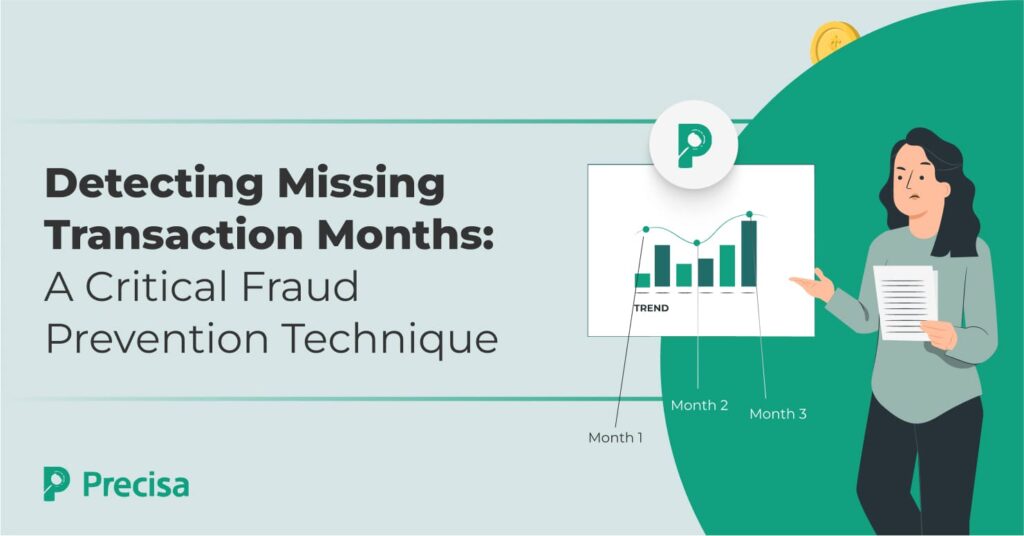Detecting Missing Transaction Months: A Critical Fraud Prevention Technique

Detecting missing transaction months might sound like a boring bookkeeping job. But fraudsters love to exploit gaps in your paperwork. Modern tools like Precisa make it possible to spot these gaps automatically, so risky omissions don’t slip past busy reviewers.
When you, as a lender, accountant, or compliance officer, review bank statements, you depend on complete data. If a month is missing, it raises a big red flag. Maybe a borrower is hiding a loan. Or a business is covering up strange cash flow.
So next time you go through financial records, pay close attention to missing months.
What Are Missing Transaction Months?
A missing transaction month happens when bank statements or accounting records skip one or more months. Normally, banks send you a statement every month. These statements show the time period, your opening and closing balances, and every deposit and withdrawal you made.
Incomplete coverage can occur for innocent reasons, but it can also indicate:
- Deliberate omission of incriminating transactions: Fraudsters might exclude months with fraudulent transfers or unusual cash inflows to avoid detection.
- Errors during document compilation: Manual downloading or scanning of statements can miss a month, especially when dealing with multiple accounts.
- Data manipulation: When fake bank statements are generated using publicly available templates, certain months may be intentionally omitted to make the data fit a fabricated narrative.
Precisa addresses these challenges by checking uploaded statements for continuity. Its Bank Statement analyser highlights gaps in coverage so compliance teams can act quickly.
Why Detecting Missing Months Matters for Fraud Prevention?
Missing or altered statements are often a red flag for potential financial fraud. Precisa’s advanced monitoring capabilities allow you to automatically flag missing or inconsistent monthly statements, making it easier to spot anomalies before they become a bigger issue.
Hidden Income or Debt
Lenders rely on bank statements to verify income, expenses and repayment capacity. Omitting a month can conceal large one‑off inflows or unrecorded withdrawals.
Precisa’s monthly counterparty analysis highlights recurring receipts and payments, making sudden absences in cash flow easier to identify.
Masking Suspicious Patterns
Fraudsters love to hide shady activity. They might skip months when they did circular transactions, made duplicate entries, or had big spending spikes. These are common signs of money laundering or document tampering.
Precisa’s circular transaction detection and time-series analysis make it easier to surface patterns even when data appears incomplete.
Compliance and Regulatory Risk
With strict anti-money laundering and Know-Your-Customer rules, you need to be extra careful. Regulators expect you to check every detail. Going through all bank statements helps verify where the money came from and spot fake documents.
Protecting Against AI-Driven Document Fraud
Modern fraudsters use AI to produce convincing fake documents. A Thomson Reuters report notes that easy‑to‑download AI voice clones and deepfake technology can bypass voice and facial verification, and fraud service providers offer completely false identities with forged documents.
If criminals can clone voices, forging or omitting parts of bank statements is trivial. Detecting missing months is an additional safeguard against such AI-generated fraud.
Precisa’s authenticity checks verify that uploaded e-statements are genuine, while its irregularity detection flags when statements look suspiciously clean or incomplete.
Techniques for Detecting Missing Transaction Months
Comprehensive Document Collection
The first step is to gather all bank statements for the period you want to review. Make sure you get statements for every single month. Double-check the dates to avoid any gaps. Digital tools make this much easier. They can automatically fetch statements using account aggregators or secure APIs. This saves you time and makes sure you don’t miss anything.
Data Extraction and Normalisation
PDF validation by hand is slow and easy to mess up. Modern bank statement analysis tools can pull data from different formats like PDF, XLS, or CSV. They turn everything into a uniform digital format.
This helps you capture every month. The software can also automatically check the date ranges. If a month is missing, it will flag it right away.
Transaction Categorisation and Pattern Analysis
Once the data is digital, the next step is to sort transactions by type. Label them as income, expenses, or transfers.
Then you can look for odd patterns. Things like round-number transactions, unexplained overdrafts, duplicates, or big spending spikes stand out.
Often, missing months go hand in hand with these anomalies. Using time-series analysis helps you spot periods where data just doesn’t add up.
Reconciliation and Cross‑Checking
After you’ve extracted and categorised the data, it’s time to reconcile it. Compare the statements against your internal accounting records. This helps you catch any discrepancies early.
It’s not just about matching amounts. It also makes sure no month is missing. Regular reconciliation should be part of your fraud prevention routine.
Use of Anomaly‑Detection Algorithms

AI, ML & blockchain in money trail detection is great at spotting hidden problems. These algorithms study normal transaction patterns over time. Then they flag anything unusual, like missing months or strange spending habits. For example, the AML analysis helps you spot signs of money laundering and other suspicious activity.
Advanced AI models learn normal patterns and alert you to anomalies. AI can even score how risky an account is. While it helps prioritise high-risk accounts, Precisa takes detection further. It identifies missing months and irregularities in real time, making investigations more efficient and accurate.
How Precisa Detects Missing Months and Other Irregularities
Precisa is a cloud‑based bank statement analysis solution serving lenders, NBFCs and DSAs across India. It is compatible with over 500+ banks and 1000+ bank formats, processing millions of statements and transactions. Key features include:
- Authenticity checks: Precisa verifies that uploaded e‑statements are genuine and not manipulated.
- Irregularities tab: The platform detects potentially suspicious transactions and highlights them in an “Irregularities” tab. It can identify at least 12 types of suspicious activity.
- Counterparty and monthly analysis: Users can see recurring receipts and payments from specific individuals or businesses via a “monthly counterparty tab,” making it easier to spot missing months.
- Comprehensive categorisation: Precisa recognises more than 90 inflow and outflow categories to classify income and expenses. This granular categorisation helps identify anomalies such as skipped months or unusual cash flows.
- Circular transaction detection: The tool screens for circular transactions – fictitious patterns that inflate bank balances – and reports them in a dedicated tab.
- Precisa Score: By considering parameters such as overdraft usage, transaction volatility and anomalies, Precisa calculates a creditworthiness score to summarise risk.
- Multi‑account analysis: It can aggregate multiple accounts to give a holistic view of an individual’s or business’s financial health.
These features are powered by AI and machine learning. When you analyse a borrower’s statements, Precisa automatically checks if every month is there.
If a month is missing, the system flags it in the Irregularities tab. It even reminds you to ask for the missing statement. Precisa also cross-checks transaction dates to make sure there are no unexplained gaps. By automating this, you can cut manual review time from hours down to just minutes.
Stop missing months from hiding risk in your portfolio. Schedule a consultation now and find out how Precisa automates detecting missing transaction months.



